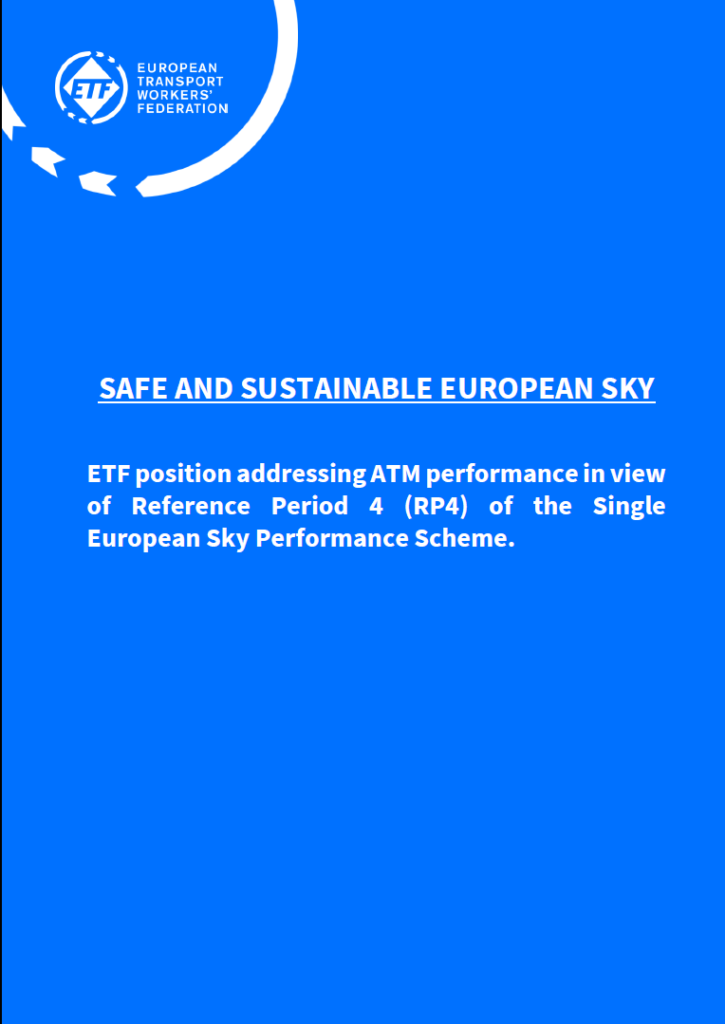ETF calls for fair distribution of airspace charges
The European Transport Workers’ Federation (ETF) today outlined its views on how the Air Traffic Management system should function in the future after thoroughly analyzing how the sector reacted to the different crises it had faced.
The ETF released today its vision for the Air Traffic Management (ATM) performance charging scheme given the proposal for Reference Period 4 (RP4) of the Single European Sky (SES) Performance Scheme starting is expected to arrive soon.
In its Position Paper on ATM performance, the ETF criticizes the current Single European Sky performance scheme on Reference Period 3 (RP3) for being unrealistic and disproportionate, focusing mainly on cost efficiency while disregarding the other Key Performance Areas used in the ATM system.
As explained in the Position Paper, ETF considers the 5-year timespan of the SES Reference Periods to be too stringent, thus, not allowing for more investment and flexibility to adapt to traffic deviations from forecasts which have shown to be strongly influenced by events outside of ANSPs’ control, such as the crisis in Syria in 2015 or the war in Ukraine more recently.
‘Before the new charging period starts – says Eoin Coates, Head of ETF Aviation Section – ‘the industry needs a common plan, jointly agreed with all the stakeholders, on how to update the way ATM system will work in the future so that it can properly respond to future challenges. The best way to do that is through lessons learnt, which implies assessing how the system reacted to the many different crises it has faced and making changes where it has failed.’
A measure the ETF strongly advocates for is a new change management indicator designed to track and monitor changes within specific processes throughout the reference period. ETF believes that an adequate ‘change management system’ could reduce disruptions and chaos for airspace users through the application of managed change and is a good investment, especially considering the focus on the high levels of change-related human factors in the ATM systems.
Gauthier Sturtzer, Chair of ATM Committee at ETF, underlines:
‘We believe a fit-for-purpose and well-managed process is a must. It is a way to ensure we fully benefit from any new technology the European ATM system may use based on the huge EU investments. Also, the human factor should be an essential part of this process. It would be a capital mistake to ignore that the success of technological changes is directly dependent on the people using the new technologies.’
ETF also calls for a single Key Performance Area, which takes into consideration the strong interdependencies between the 4 Key Performance Areas (KPAs) of the ATM system: safety, environment, capacity, and cost efficiency. A single Key Performance Area, instead of having separate Key Performance Areas, would be the best approach, as it would reflect the complexity of the system providing Air Navigation Services and the interdependencies in the sector.
Furthermore, based on a solid analysis of the 4 Key Performance Areas, ETF proposes in its Position Paper some key changes for each of the KPAs, as follows:
- An Annual ATM Safety report to be produced by EASA and the European Commission;
- Environment – To establish a mandatory route selecting service under the coordination of a centralized entity/body managing the ATM network;
- A new capacity measure based on separate evaluations of management, staff, technological means/tools, and airspace changes;
- A new ‘ATM Funding’ KPI to replace and regulate the cost-efficiency dimension of the ATM system, allowing it to function under national rules while also ensuring the independence of ANSPs in setting specific costs.
